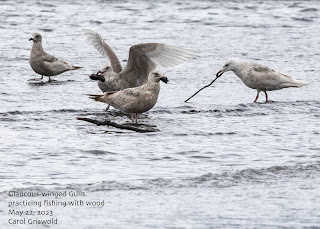Seward, Alaska
Sunrise 4:55 am, sunset 10:57 pm for a total day length of 18 hours and 1 minute. Tomorrow will be 3 minutes and 46 seconds longer.
More gray skies and light rain with temps from 35 to 42 at sea level; snow reported on the Race Point of Mt Marathon. Getting used to this cool, rainy weather.
Driving past the Mile 1 Nash Road wetlands, I was surprised and elated to see a majestic Bull Moose posed like a statue in the newly emerged horsetails and other aquatic vegetation. What a massive, prehistoric-looking animal! I usually only see the cows and youngsters, also impressive, but not like this!
He stood at attention, scrutinizing the nearby woods, then relaxed to feed. After a while, he leisurely strode to the edge of the pond and walked in. I wondered how deep it was; deep enough for him to swim. Those big ears swiveled towards the wary and watchful nesting TRUMPETER SWANS. I have no doubt they would have been triumphant over even such a monster as this.
Fortunately, the moose was not at all interested in finding out, and swam past. He shook off vigorously, water flying, as he emerged on the other side. After a few more bites of green, he wandered off and disappeared. Wow. How can this huge beast survive on greens and shoots? Incredible.
I checked out Spring Creek Beach. The wetland pond is still flooded from a winter storm surge that flung up enough gravel and cobble to block the outlet. Spruce, alders, willows, and beach rye grass are several feet underwater. The sockeye smolt can’t get out and the adults can’t get in to spawn.
A pair of GADWALL paddled along the pond ahead of me. This pair has been here for the past week or so, often in a small intertidal pool. They are alert, but very tolerant. The hen took a bath then waddled ashore to preen while the drake waited a safer distance away. It was so fun to watch her arranging all her feathers without any fear. Beautiful hen and very handsome drake.
A few BARROW’S GOLDENEYES dove offshore with SURF SCOTERS, PIGEON GUILLEMOTS, 3 MARBLED MURRELETS, and HARLEQUIN DUCKS. A Sea Otter cruised past, swimming backwards as usual, with lunch on its belly, and Steller Sea Lions porpoised along.
A BELTED KINGFISHER rattled overhead while a LINCOLN’S SPARROW sang in the rain from the spruce tip. Unseen, a SONG SPARROW replied from the protection of spruce boughs. I suspect AMERICAN CROWS have nests in these dense spruce trees as one chased me off.
A few optimistic fishermen cast into the waves, hoping to snag a newly arrived Red Salmon. Despite their presence, three SURFBIRDS foraged on the algae-covered rock jetty. Their coloration blended in perfectly, as it does on the barren gravel ridges in the tundra and mountains. These seem late; over 20 were here last week. Time to nest!
On the way home, I just missed a big event at the mile 1 Nash Road wetlands. Both Swans were trumpeting loudly, their wild voices ringing and echoing off the nearby mountainside.
After shimmying and fluttering, heads bobbing up and down, they each in turn stretched their angel wings to release energy. It seemed they had just scored a major victory against an unseen (to me) foe and driven it away. Then the pen (female) paddled back to her nesting duties and the cob (male) resumed eating, both parents still on duty.
My morning began with the plucky male RUFOUS HUMMINGBIRD surveying his kingdom from the power line along the alley behind my house as nesting VIOLET-GREEN SWALLOWS swooped around him. “My” birds. It’s just so amazing that they returned to the same place after migrating so many, many treacherous miles.
This wonderful day ended with the sweet serenade of the HERMIT THRUSH, so tranquil. I feel so lucky!



































































